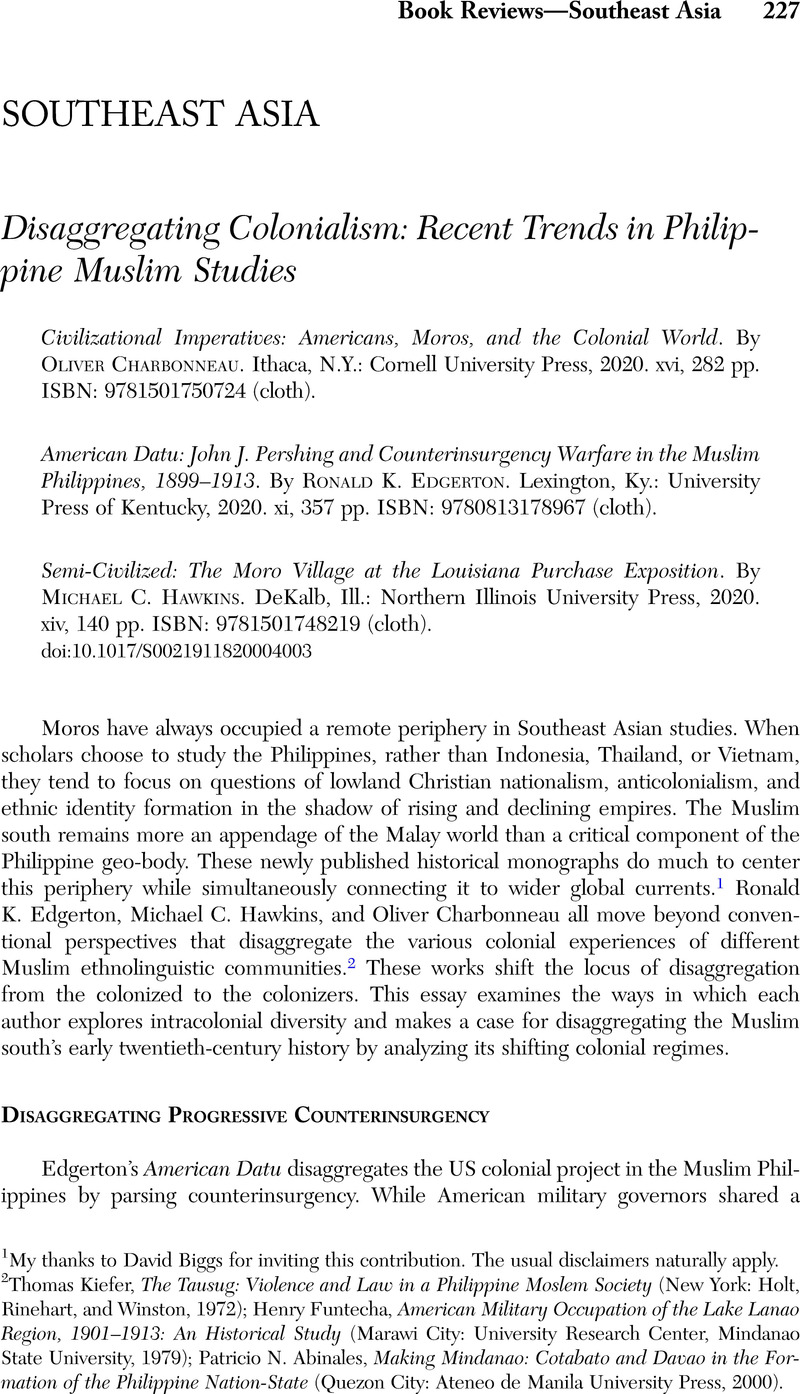No CrossRef data available.
Published online by Cambridge University Press: 25 February 2021

1 My thanks to David Biggs for inviting this contribution. The usual disclaimers naturally apply.
2 Kiefer, Thomas, The Tausug: Violence and Law in a Philippine Moslem Society (New York: Holt, Rinehart, and Winston, 1972)Google Scholar; Funtecha, Henry, American Military Occupation of the Lake Lanao Region, 1901–1913: An Historical Study (Marawi City: University Research Center, Mindanao State University, 1979)Google Scholar; Abinales, Patricio N., Making Mindanao: Cotabato and Davao in the Formation of the Philippine Nation-State (Quezon City: Ateneo de Manila University Press, 2000)Google Scholar.
3 Edgerton adds further complexity to Abinales, Patricio N., “Progressive-Machine Conflict in Early-Twentieth-Century U.S. Politics and Colonial-State Building in the Philippines,” in The American Colonial State in the Philippines: Global Perspectives, ed. Go, Julian and Foster, Anne L. (Durham, N.C.: Duke University Press, 2003), 148–81CrossRefGoogle Scholar, which divides the colonial archipelago into progressive and patrimonial macro-regions.
4 American Constabulary officers in lowland Christian zones further north also facilitated the political advancement of loyal Filipino elites, albeit in a more national direction. For this process, see Cullinane, Michael, Ilustrado Politics: Filipino Elite Responses to American Rule, 1898–1908 (Quezon City: Ateneo de Manila University Press, 2003)Google Scholar.
5 Many American commanders felt they had done native peoples back home a bad turn and should try to do their new Muslim wards a better one. I thank Michael Hawkins for emphasizing this point to me.
6 Mukhopadhyay, Dipali, Warlords, Strongman Governors, and the State in Afghanistan (New York: Cambridge University Press, 2014)CrossRefGoogle Scholar. Sociopolitical developments since the 1970s have made the Muslim Philippines more like Afghanistan; Edgerton does not take this into account. For more on emerging Afghan/Muslim Philippine analogies, see Vartavarian, Mesrob, “Warriors and Colonial Wars in Muslim Philippines since 1800,” in Racial Difference and the Colonial Wars of 19th Century Southeast Asia, ed. Noor, Farish A. and Carey, Peter (Amsterdam: Amsterdam University Press, 2021), 243–71CrossRefGoogle Scholar.
7 Kramer, Paul, “Making Concessions: Race and Empire Revisited at the Philippine Exposition, St. Louis, 1901–1905,” Radical History Review 73 (1999): 74–114Google Scholar.
8 Stoler, Ann Laura, Capitalism and Confrontation in Sumatra's Plantation Belt, 1870–1979 (Ann Arbor: University of Michigan Press, 1995)CrossRefGoogle Scholar.
9 Vartavarian, Mesrob, “Imperial Ambiguities: The United States and Philippine Muslims,” South East Asia Research 26, no. 2 (2018): 138–39CrossRefGoogle Scholar.
10 For a detailed study of this campaign, see Smythe, Donald, “Pershing and the Mount Bagsak Campaign of 1913,” Philippine Studies 12, no. 1 (1964): 3–31Google Scholar, esp. 23–24. In this instance, the Moro troops in question came from Cotabato and Lake Lanao.
11 Vartavarian, “Imperial Ambiguities,” provides further discussion of dominant administrative characteristics during distinct colonial phases.
12 Milner, Anthony C., Kerajaan: Malay Political Culture on the Eve of Colonial Rule (Tucson: University of Arizona Press, 1982)Google Scholar; Donna J. Amoroso, “Inheriting the ‘Moro Problem’: Muslim Authority and Colonial Rule in British Malaya and the Philippines,” in Go and Foster, The American Colonial State in the Philippines, 118–47.
13 Vartavarian, “Imperial Ambiguities,” 139–41.